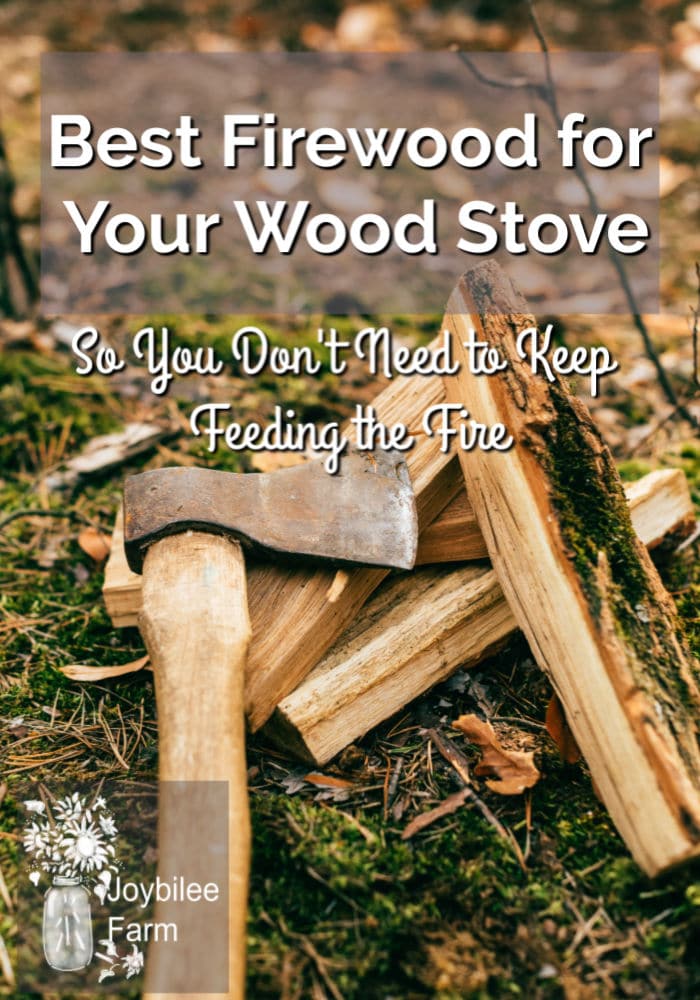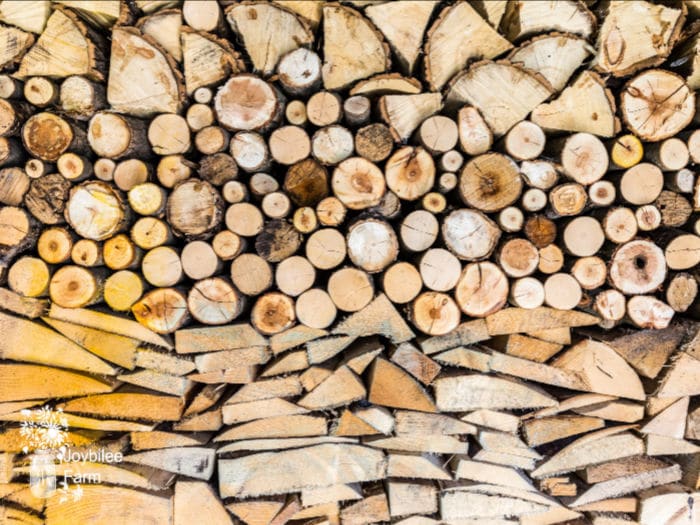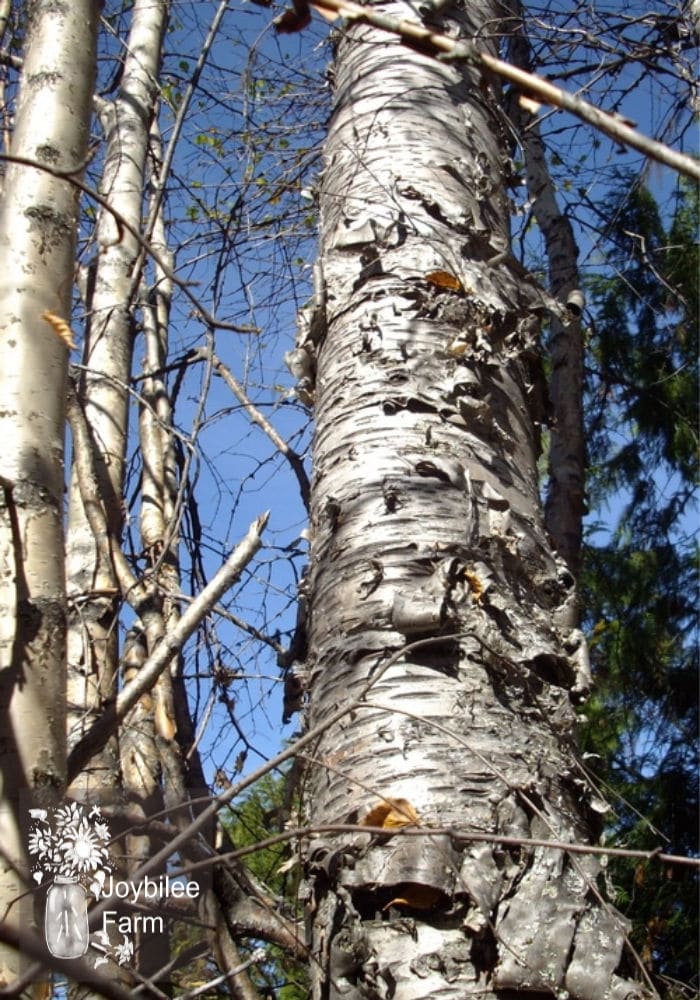Take the guesswork out of burning wood for heat and cooking with the best firewood tips to help your burn efficiently and effectively, including a firewood BTU chart that you can reference as you stock your woodshed.
The kind of wood you burn in your fire can make a difference in how warm your home stays, whether your bread will bake evenly in a wood cook stove, or even how much wood you’ll go through in a season. The kind of wood you burn can even effect the cost of your home insurance, as well as how much your annual firewood costs you. And the key to lower heating costs, less wood storage space, and less costly home insurance is burning wood with higher BTUs.
Wood fuel is rated by the term “BTU” which stands for “British Thermal Unit” and is defined as the amount of energy required to raise 1 pound of water 1 degree Fahrenheit. The term BTU describes the energy content of fuels. The higher the number rating, the better the fuel is for creating even, sustained heat for home heating and for cooking.

What makes the ideal firewood?
All firewood that is in an ideal condition for using in a wood-burning stove or wood cookstove is:
- Dry and seasoned
- Free or low cost
- Locally available
- Makes use of windfalls, dead trees, dangerous trees, or selectively harvested trees
- Doesn’t endanger the operator
- Is untreated with chemicals
- Has a high BTU (more about BTUs below)
Do your best to have your winter wood stacked and stored by the end of August and if this is your first year, cut or purchase enough wood to get you through two seasons. Some wood takes 12 to 18 months to properly cure for burning. This wood needs to dry before you start using it.
If you don’t have the time to dry it fully, you’ll find that burning green wood is frustrating. It doesn’t give off as much heat because the energy in the wood that you need to heat is being used to evaporate the water in the wood.
Green firewood will have sap and resins that can cause problems in your wood stove and flue. Green wood also causes creosote to build up in your chimney that can lead to dangerous chimney fires. Take the time to properly season your firewood and bring home twice the wood that you think you need. This is the most important point, whatever wood you choose to burn.

Determine your wood needs
Your heating needs depend on where you live and how well insulated your home is. Everyone’s needs are different. Wood that you would use to heat your house can be used for cooking with some craft and wisdom.
Although your wood cook-stove can be used to heat your home when you want to cook with fire you stoke the fire differently. You want your wood to catch fire quickly, and have a long burning time. Ideally, we plan on making a quick fire with lower BTU woods if we are getting the fire going in the morning or need to bring food to a boil or a simmer on the cooktop. This quick burn heats the cooking surface fast. When you are baking or roasting in the oven you’ll want to use denser woods with a higher BTU, to burn more slowly and give an even heat, sustained heat, for slow, even cooking temperatures.

Grab your copy of this free resource using the link at the bottom of this article.
Scenario Number One
With the available woods that I have here in BC, I might start the woodstove with lodgepole pine logs, cedar kindling, and a few alder logs. Once the fire is going I then feed it with pine, spruce, aspen or alder to keep it going on a cold day. These woods have a lower BTU but give off fast heat. Using lower BTU woods means that you have to add fuel more frequently, but there is a nice tradeoff. They are the readily available woods here on our property, so we have more wood available like this than the higher BTU woods, like birch and larch.

Scenario Number Two
When I want to bake or roast in the cookstove oven, I need to add a longer burning wood with a higher BTU. Larch or birch (with a BTU around 22.0) would give me the most heat for the longest burning. If you live on the East Coast or in the South, you have the benefit of eastern hardwoods, most of which, have higher BTUs (in the 25-30 range) than the available Western woods.
Scenario Number Three
In Spring, when you wake up to a cold house but you know that the sun will come in the windows and heat the house by noon, you want to light a quick, fast fire that will take the chill off the house and heat your coffee pot, fry a few eggs and then quit for the day. This is when you would use the lower BTU woods. Willow, aspen, spruce (in the range of 14-15 BTU’s) are ideal for a quick, hot fire to take off the chill the house. We then let the fire go out so that you aren’t sweltering later in the day.
How much wood do you need?
People often underestimate their firewood needs in the summer. A cord of wood, which is 128 cubic feet (or 4x4x8 feet), looks like a lot of wood when the sun is shining and you have other tasks to do. But in February, when the snow is still 4 feet deep, and the wind chill is -28C in the sunshine, it can take all day to bring home enough green wood to heat your house for one day.
We’ve learned to bring in twice the firewood that we need while the sun is shining in July and August. This gives the wood has a chance to dry and you can then spend your February days reading by the fire, instead of hauling wood. This will ultimately save money and maybe even prevent a costly chimney fire.
Our rule of thumb is if you think you’ll burn 3 to 4 cords for the year, bring home 8 cords. Then the next year, fill your wood storage back up to 8 cords. This way you’ll stay ahead of your needs for dry wood and should unforeseen circumstance prevent you from getting wood next summer you will have dry wood to keep you going.
Do further research at the National Ag Safety Database from Clemson University to really narrow down the amount of wood you’ll need to get through the winter.

Firewood BTU Ratings
In Western North America, there are many dominate trees that are considered softwoods. Trees like pine, cedar, spruce, fir, and willow. Other trees like birch, larch, alder, and walnut are considered hardwoods. Conventional wisdom says to burn hardwoods, but some softwoods actually give you more fuel value. Dominant woods will differ as you move across the country and you should always use the available woods in your area.
Commonly available woods and their BTUs
| Hickory | 30.8 |
| Northern Red Oak | 24.3 |
| Western Larch (Tamarack) | 22.3 |
| Douglas Fir (Red Fir) | 20.6 |
| Lodgepole Pine | 17.5 |
| Alder | 17.2 |
| Ponderosa Pine (Yellow Pine) | 17.1 |
| Grand Fir (White Fir) | 16.7 |
| Spruce | 15.0 |
| Aspen | 14.7 |
| Subalpine Fir | 13.6 |
If you want to explore this topic further there is a useful pdf download from the Coleville National Forest, focused on heating with wood. This free pamphlet also offers a comparison of other fuels with wood heating and allows you to compare the relative costs of each choice for home heating based on BTUs.
It gives the formula for calculating heating costs and tells me that if my alternate home heating is electric baseboard heaters and I am paying 10 cents per kWh then if a cord of firewood cost less than $300, I’m ahead. This summer a truckload of larch (3/4 cord) was $200 in my region, up from $140 just 7 years ago.

BTU of 25 firewood species chart
Explore the BTU ratings of 25 different firewood species with this downloadable chart and get my best tips for Firewood storage and safety by clicking the pink Free download button below.
Other Articles in the Firewood Series
12 Practical Reasons Why Cooking with Wood Makes Sense
Wood Heaters vs. Wood Cook-Stoves: How to Choose
9 Ways to Use the Ashes From Your Woodstove Around the Homestead
13 Tips to Keep a Wood Cook Stove Functioning at Peak Efficiency
15 Ways to Stay Warm in Winter Without Turning Up the Heat
Best Fire Starter — How to Make Char Cloth
10 Tips for Choosing the Perfect Wood Cook-stove
How to Light a Fire in a Woodstove Without Getting Burned
Is Wood Heat Eco-Friendly and Sustainable?
The Best Firewood Storage Ideas to Keep Your Firewood Dry
Did I miss anything? Do you have a wood heating experience to share with our readers? I’d love to hear from you, leave a comment below.



Tocudhown! That’s a really cool way of putting it!